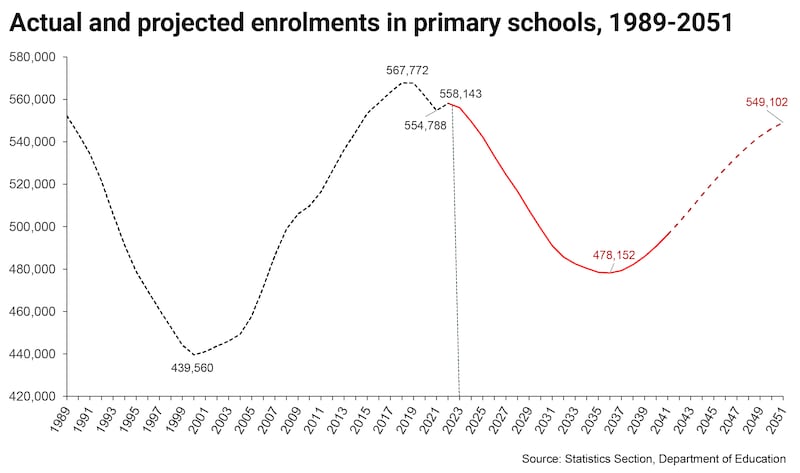For years there have been two constants in education: a teacher supply crisis and complaints about overcrowded classrooms.
Within the next decade we could face a sudden reversal: an oversupply of teachers and near-empty schools in less populated areas.
That is the picture painted by a Department of Education report which projects a drop of 100,000 in pupil numbers, or almost one-fifth, over the next decade at primary level. At second level, student numbers are set to peak in 2026 before declining.
These demographic patterns are driven by a recession-era baby boom. The bubble has passed through the primary school system and will transfer into second level over the coming years.
READ MORE

So, what are the implications for schools, teachers and pupils?
Class sizes at primary level are, on average, larger than elsewhere in Europe, with about 23 pupils per class in Ireland compared with an average of 20 in the EU. Progress has been made over recent years in reducing pupil-teacher ratios, but we’re still an outlier.
The projected decline in pupil numbers will give future ministers for education an opportunity to reduce class sizes further and finally bring them into line with EU averages.
Groups such as the Irish National Teachers’ Organisation (INTO) say smaller classes are vital to ensure every child has the chance to reach their full potential.
Not everyone agrees. For example, the OECD’s director for education and skills, Andreas Schleicher, says there is “zero correlation” between quality of tuition and class sizes.
There is also likely to be an oversupply of teachers, especially at primary level.
The Department of Education has previously projected an oversupply of 13,000 teachers by 2029. At second level the over-supply is less dramatic, largely because pupil numbers are projected to rise up to 2026, before declining slowly.
Reducing pupil-teacher ratios may absorb much of this oversupply.
Growing demand for special education may also ensure there is plenty of work for teachers. Some 300 special classes are due to open this year alone, with lower pupil-teacher ratios of six to one.
The future for some schools may be bleak, however.
Ireland already has the highest proportion of small schools in Europe. Nearly half of our primary schools have four teachers or fewer. However, they account for just 15 per cent of the primary school population. Most of these schools are in the west, where local populations tend to be static or falling, and getting older.
The department’s official policy is that schools close only with the consent of parents or a board of management. While there is generally little appetite in closing down schools, attitudes can quickly change when numbers cross a tipping point.
Parents in many parts of Dublin and in commuter belt areas, meanwhile, are struggling to find school places.
While a decline in pupil numbers holds the promise of these issues easing, it may not work out like that in practice across many local areas. Demand for school places is projected to rise in many areas, even as pupil numbers fall nationally.















